It would be hard not to say that matchday nine of the Championship was one of the most fascinating rounds to watch this season. Among the clashes of the big names, Queens Park Rangers and West Bromwich Albion was also another must-watch clash on Saturday evening. Both teams were close to each other on the league table, with the former stood fifth and the latter fourth. With that in mind, the fans expected to be treated with a thrilling clash at the Loftus Road.
It’s fair to say that QPR have taken the league by storm under Mark Warburton. They secured five wins and a draw after the first eight matches, a record that surprised many people. Furthermore, free-scoring wasn’t something familiar with the team under Steve McClaren. But QPR registered fourteen goals before this match, the second-highest record just below their opponent, West Brom.
Keeping the unbeaten streak from the start of the season is a tough job, but Slaven Bilić’s West Brom have dealt with it perfectly. With four wins and four draws under their belt, the squad was in high confidence when they travelled to London, and they transferred that onto the pitch by securing their fifth win of the season. Two goals from Nathan Ferguson and Matheus Pereira in the second half meant three points were theirs at the end of the day.
This tactical analysis will provide an analysis of West Brom’s 2-0 win over Queens Park Rangers. Meanwhile, using statistics, we will point out why didn’t Warburton’s tactics work out for them against Bilić’s tactics.
Lineups
The home side lined up in a 5-3-2 formation without any significant changes from the side that secured three points against Millwall. Captain Grant Hall remained a doubt for QPR before the game and Warburton didn’t take the risk of playing him in his five-man defence. Meanwhile, QPR’s manager also confirmed that Bright Osayi-Samuel and Lee Wallace were ready for their returns and they both eventually made the bench.
Nahki Wells hoped to continue the form that helped him secured four goals in the last two matches. At the same time, his partner, Jordan Hugill was also expected to add to his tally of five goals. Playing below them was another player who also had a terrific run in Eberechi Eze, who had three goals and two assists to his name.
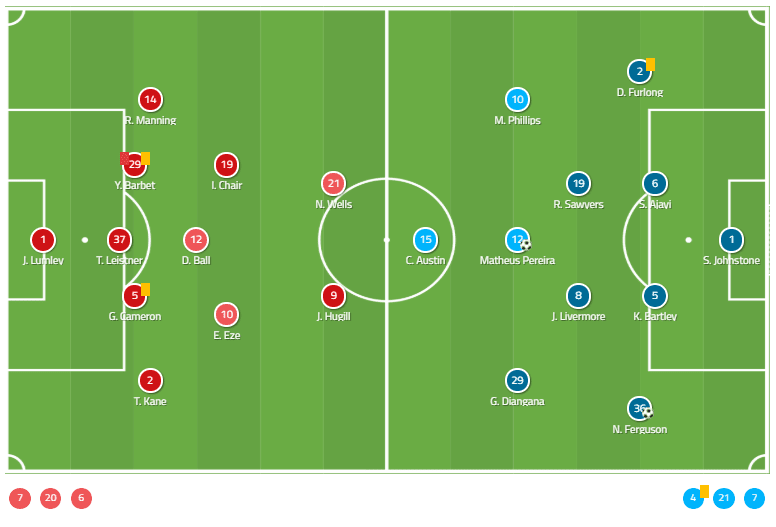
West Brom, on the other hand, only saw one change to their usual 4-2-3-1 formation from their match against Huddersfield. West Ham loanee Grady Diangana stepped into the side as he occupied the left-winger spot, pushing Pereira into Filip Krovinović’s central attacking midfielder position.
It was thought that Bilić might have welcomed Ahmed Hegazi back into the side after he involved an hour in an under-23 game. But he wasn’t registered for the bench as youngster Dara O’Shea filled in the place. Kieran Gibbs also made the trip after his recovery from an ankle injury while another full-back in Conor Townsend missed out once again.
QPR’s style of play
Entering the match with a 5-3-2 formation, some might think QPR would employ a more defensive style of play. More specifically, they would have used more direct passes into West Brom’s defensive third rather than playing out from the back. Well, things happened the opposite way, though.
QPR focused on building their attacks from the backline using the combination of three central defenders. It’s also worth notice that the home side had two centre-backs who were more than capable to involve frequently in the build-up process. With Yoann Barbet and Geoff Cameron playing as outside centre-backs, these two could pick up the ball and make penetrative passes toward the attacking players.
Playing quite deeper than his colleague, Tony Leistner acted as a safe passing option in case West Brom started to press them. He dropped deeper to create space for himself to pick up the ball and find the potential receivers for the upcoming pass. Also involved in the passing block was Dominic Ball, another centre-back who was converted into a defensive midfielder.
The former Rotherham player’s role was to connect the three centre-backs with the midfield by offering to bring the ball out of defence. He also prevented the scenario of West Brom winning numerical superiority inside their half and therefore, disrupted the build-up.
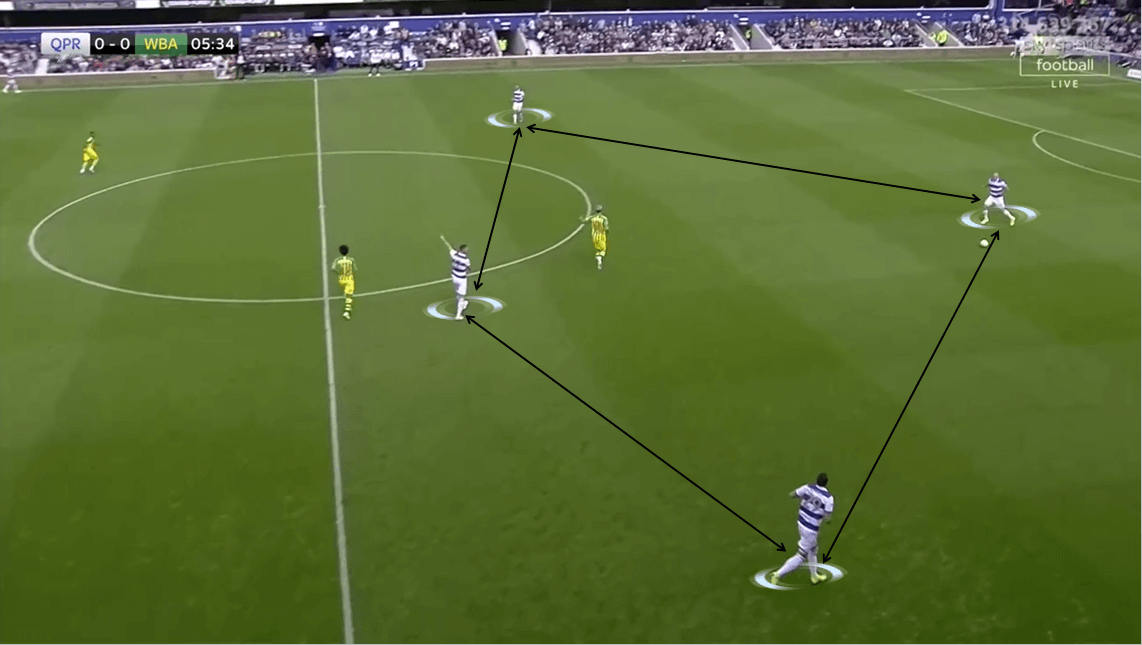
In general, they usually stretched the shape wide to force West Brom attackers to do the same. It would create gaps between them for the ball carrier to make penetrative passes into it and link up the play. As mentioned, in case the opposition pressed them, they would be able to create passing triangles to move the ball out of the overloaded area. Leistner and Ball moved close to either outside centre-back and acted as possible passing options for the ball carrier.
When they did manage to bypass the press, the ball carrier would have a clear perspective on the situation for his pass(es). Usually, his option was to distribute the ball wide for the wing-backs to overlap. Capitalising on the fact that West Brom defended narrowly, Todd Kane and Ryan Manning would position themselves inside the wide areas and ready to receive the ball.
They would pick up the pass in a free area as West Brom’s defensive structure was still shifting from one side to the other. It allowed them to make a progressive run into the final third and, if possible, aimed their cross towards the head of Hugill or Wells. This was the attacking method that QPR constantly used throughout the match. And as for the stats, both Kane and Manning registered a total of eight crosses but they didn’t have much luck on the day.
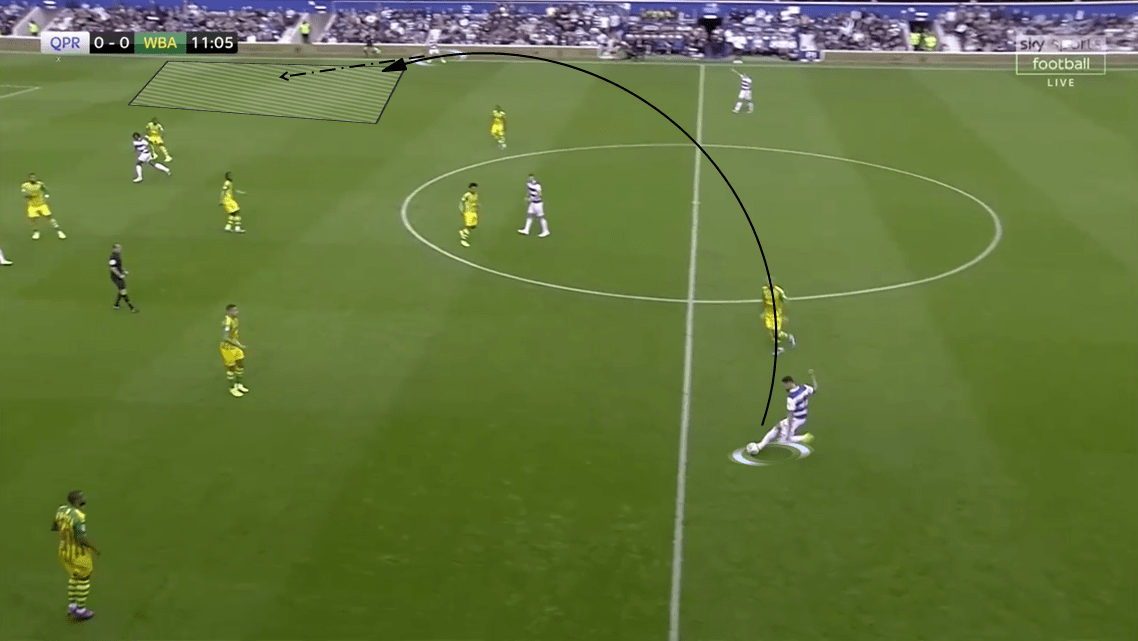
As good as they were in keeping possession through the build-up process (they had 46% of ball possession in the match), they couldn’t convert it into chances. Struggling to break down West Brom’s defence was one of the reasons that lead to the fact that they only had a total of five chances.
Occasionally, they would rely on Eze’s dribbling efforts to approach the final third. At the same time, it allowed both strikers to position themselves on the shoulders of defenders and Chair to arrive for support. But the visitor’s defenders had an efficient day in recovering possession inside their defensive third with 53% of their recoveries all came inside the area. Furthermore, most of them occurred on the edge of two thirds and the left-hand side of Manning. This showed how heavily QPR relied on the influence of the two mentioned players and the struggled they faced when these two were tightly-marked.
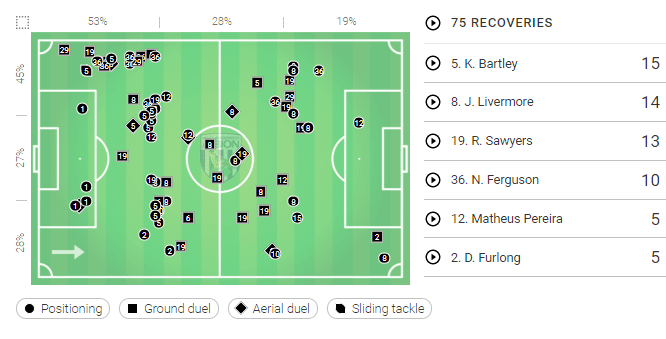
Another method which they also used to find the runs of Hugill and Wells was from long balls. Directly from the build-up process, the centre-backs would aim their passes toward both strikers. But there were two problems with this strategy. Firstly, QPR didn’t use it so often as they still preferred to play out from the back. This wasted the positioning of the strikers since Hugill and Wells could receive the ball on the shoulders of defenders and use their pace to beat the markers.
Secondly, if they did make the most out of it, they would also face another obstacle in Kyle Bartley and Semi Ajayi. They are both physical specimens with the physicality advantage (they are both 6’3″ tall). When QPR’s centre-backs made long balls towards them, it wasn’t a big problem for them to deal with as they could intercept it and win possession back for their side.
Defensively, they aimed to win the ball inside West Brom’s half using their high press. The players were instructed to every of the opposition’s players who involved in the build-up process. This allowed them to capitalise on the heavy touches or misplaced passes that the defenders made for a quick counter-attack.
But as tightly as they marked West Brom players, they opted not to go for the aggressive approach which could lead to unnecessary fouls. It also brought another disadvantage as they occasionally allowed the visitor to circulate and progress the ball high up the pitch, and therefore, bypassing the press.
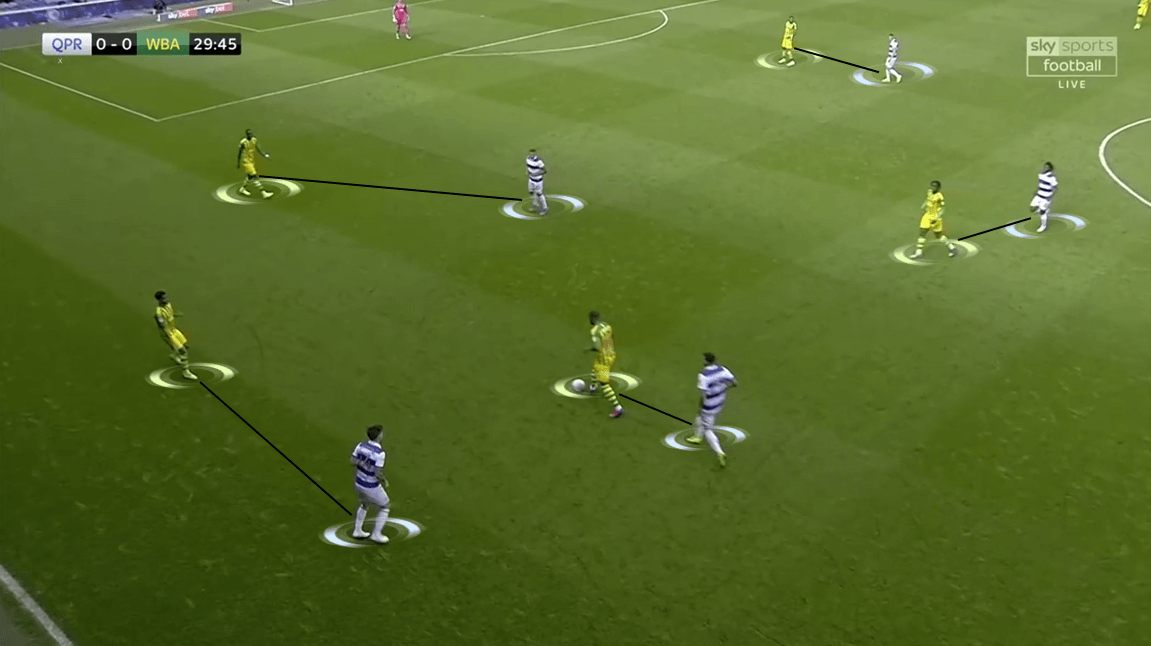
In front of their 18-yard box, forming a narrow defensive structure was their choice to deal with West Brom’s attacking threat. With at least eight players joining the shape, QPR had numerical superiority to defend zone 14 and the area behind them. At the same time, they also stretched their shape wide with both wing-backs occupied the flanks while six central players divided into three groups to fill in the half-spaces and the central space.
Meanwhile, three central midfielders took on the responsibility of shifting laterally across the pitch and attempted to nick the ball away from the ball carrier. Against players who had the ability to dribble with the ball such as Diangana, Pereira and Matt Phillips, their role became more crucial. As the defenders attempted to prevent striker Charlie Austin from breaking through into the space behind them, the midfielders would create a cage surrounding the ball carrier. They blocked three possible directions, specifically, headed towards the goal and forced a back pass.
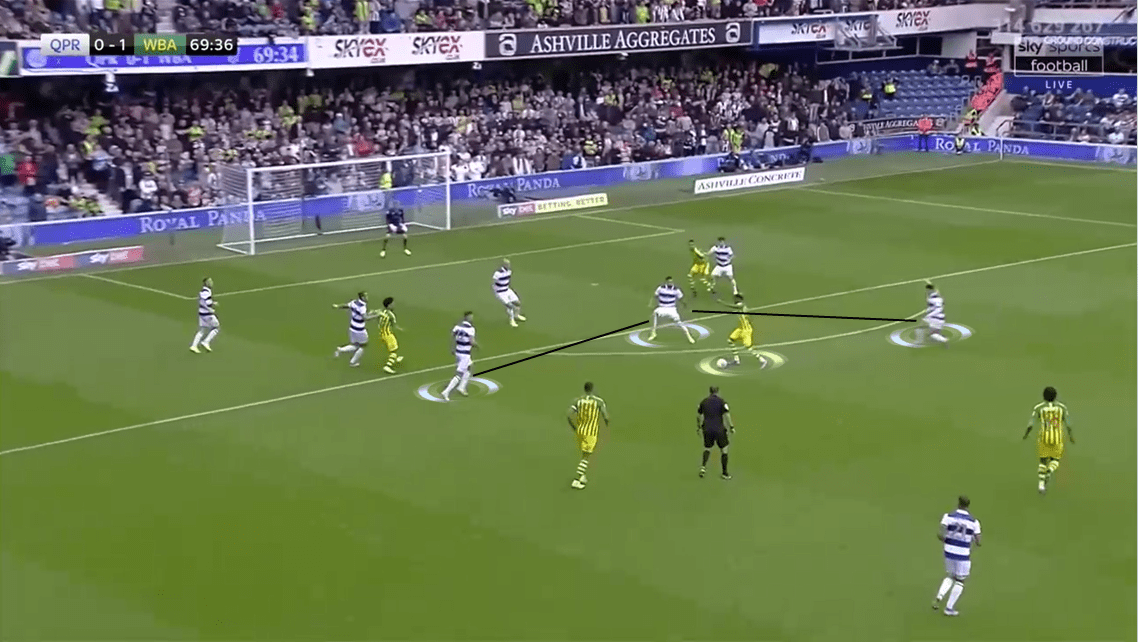
But due to the fact that the mentioned three attacking players were skilful and pacey, there were situations that they let them take a shot. In the shot above, Diangana was able to dribble his way out of the pressure and headed toward the left edge of the 18-yard box. There, his first attempt was blocked but he quickly reached the ball and forced Joe Lumley to make an outstanding save.
West Brom’s style of play
After a struggling first half in terms of finding goals, West Brom made a few changes to their tactics which helped them turned their fortune around in the second period. In the first half, they were more focused on building their attacks from the back and utilised Bartley and Ajayi’s ability. The Nigerian centre-back is a natural ball-playing defender who can make penetrative passes toward the attackers. So it’s no surprise to see him holding much of the ball during the build-up.
In contrast to what being mentioned above, the visitors were encouraged to make direct passes towards the attackers in the second half. Rather than circulating the ball among the block and waited for space to be opened up, Pereira was more active in dropping deep to turn himself into a passing option. This helped the centre-backs in finding a potential receiver for their pass, therefore, reducing their build-up time and allowed the attackers to be precise in creating and converting the chances.
To deal with the pressure from QPR’s attackers, the centre-backs would form a passing triangle with the nearest central midfielder. With both Jake Livermore and Romaine Sawyers opting to stay deep during the process, this option became more viable. Furthermore, the former Brentford midfielder had the tendency of linking up the team’s play through decisive passes and dribbles. Along with Pereira, they formed the midfield three that would help to progress the ball up the pitch and allowed both wingers to position themselves high up the pitch.
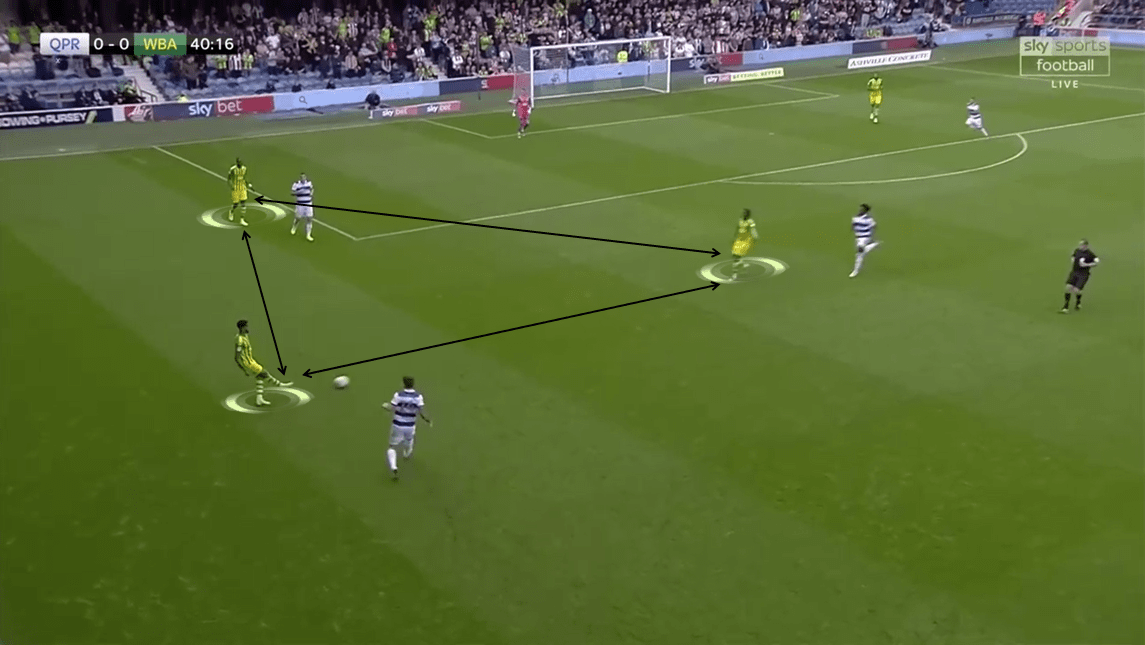
One of the most significant changes to West Brom’s style of play was that they constantly capitalised on QPR’s defensive errors. Firstly, with the home side opting to form their shape in front of the box, they left the space behind them unoccupied. With pacey players such as Phillips and Diangana, combined with target man Austin, these three would position themselves on the shoulder of defenders.
There, they were ready to receive the long ball over the top with a sprint into the area. This pinned QPR’s defensive line down and created space on the edge of the box for late arrivals to capitalise. The ball carrier had the option of aiming the cross towards Austin which allowed them to head it home, or made a back pass to the late arrivals and allowed them to shoot from distance.
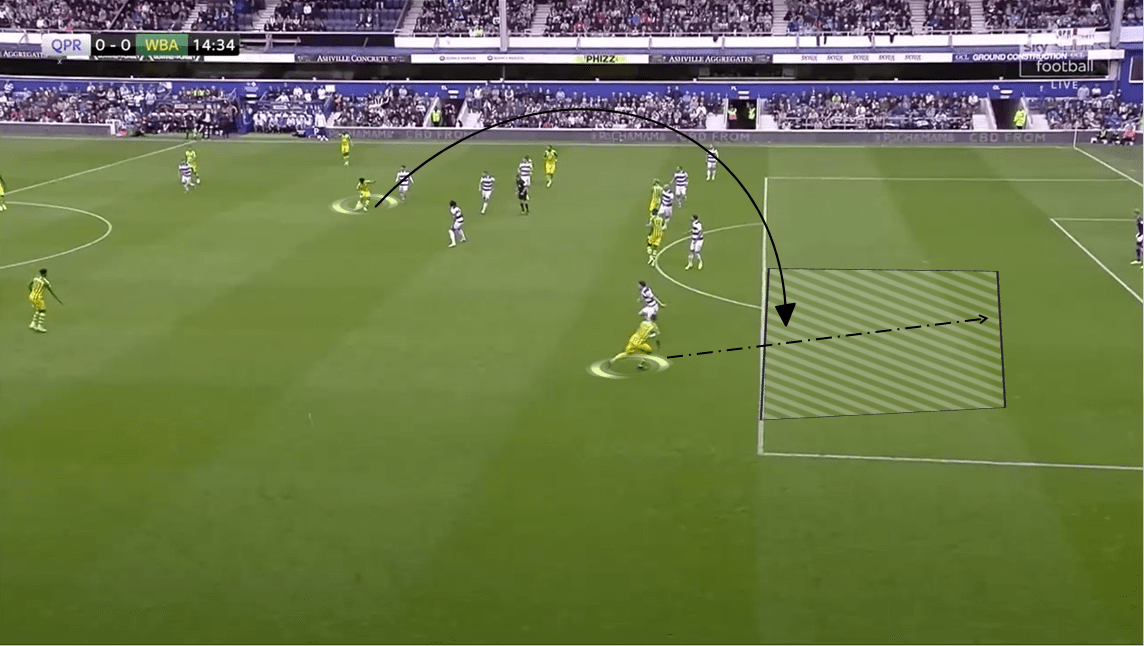
Secondly, as West Brom players constantly made flexible movements in between QPR’s defensive line, they were forced to create unoccupied gaps between the defenders. More specifically, Phillips and Diangana had the tendency of either drifting into the wide-area or cutting inside the half-spaces. It confused QPR’s defenders as they had to move along to mark them without knowing that his teammate(s) wasn’t able to occupy the gap that he left.
This allowed the ball carrier, in the shot below was Pereira, to find them through a through ball. It’s not a rare scenario in the match as West Brom constantly made the most out of this method to progress the ball into the final third.
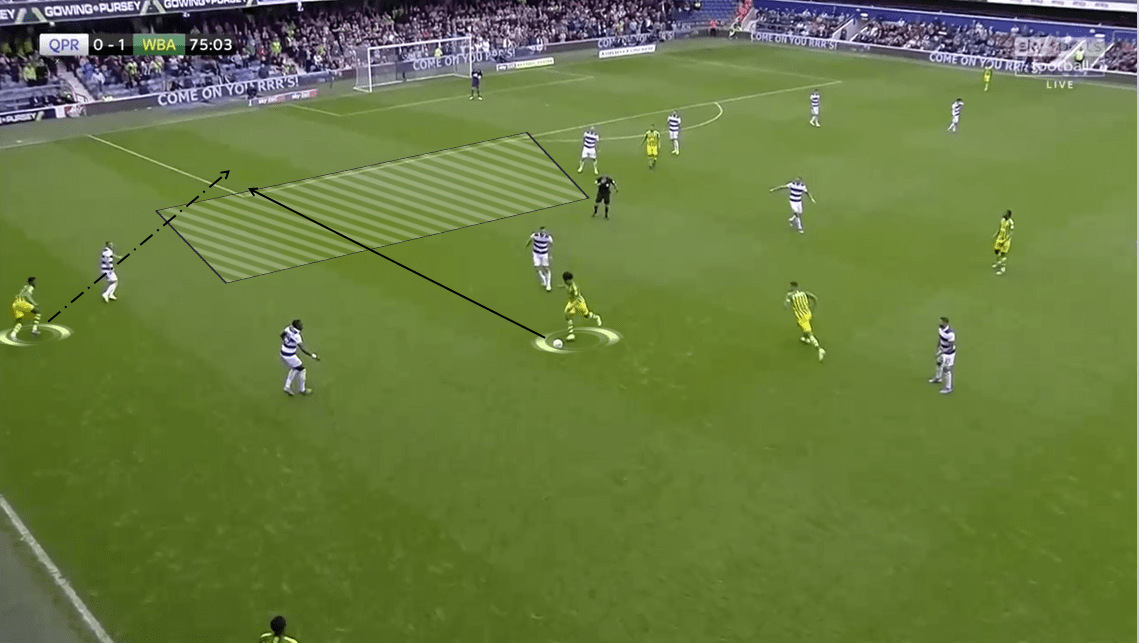
Lastly, it was the combination of the two mentioned method that led to Ferguson’s opening goal of the game. As the attackers positioned themselves on the shoulder of defenders, their movements attracted the attention of the defensive line and at the same time, pinned them down. With QPR defenders usually regrouped into the area in front of the box, they left free space for Ferguson to continue his run.
Being applied with almost no pressure from the opposition’s players, he was free to aim his shot into the bottom left corner. It’s also worth noticing that although there were three players attempted to close his shooting range down, they still let Ferguson beat Lumley with a terrific shot.
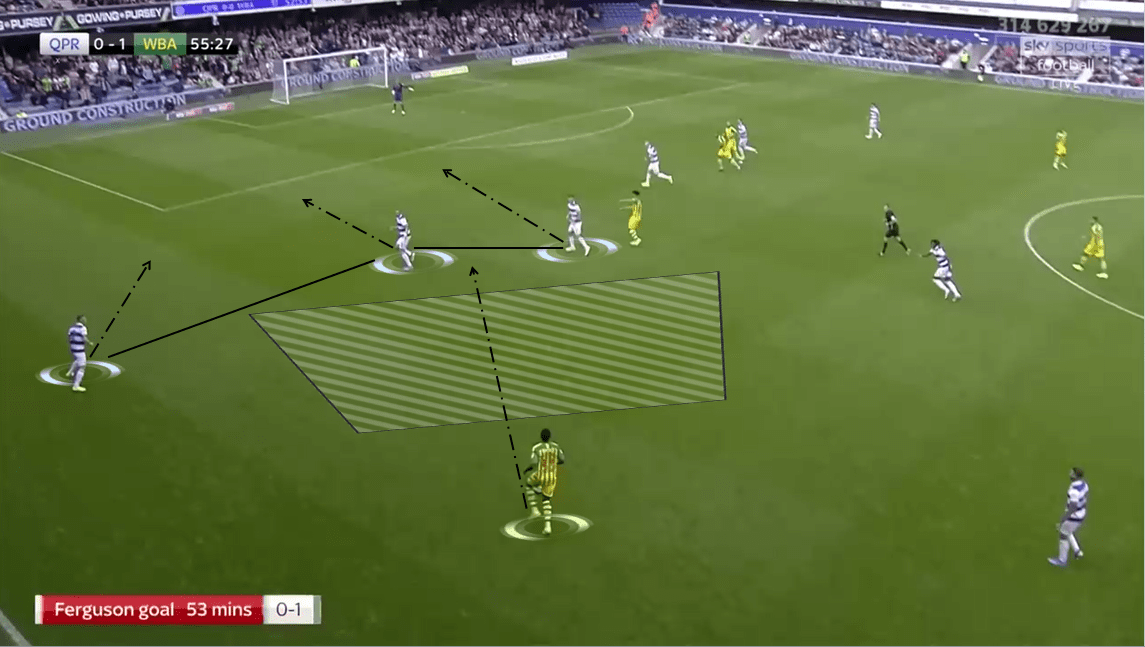
One of the reasons that allowed West Brom to control a higher rate of possession (54%) was winning more of the ball high up the pitch. By using a man-oriented press, they were able to keep QPR’s defenders in sight and allowed them to act whenever the ball came close to them.
Moreover, they employed an aggressive attitude when tackling the ball. Although it might result in more tactical fouls than they would have expected, on more occasions, the opposition’s build-up would be disrupted. Through some misplaced passes or heavy touches and by showing the ball carrier onto his weaker foot, they had a high chance of recovering possession inside QPR’s half and created a quick counter-attack.
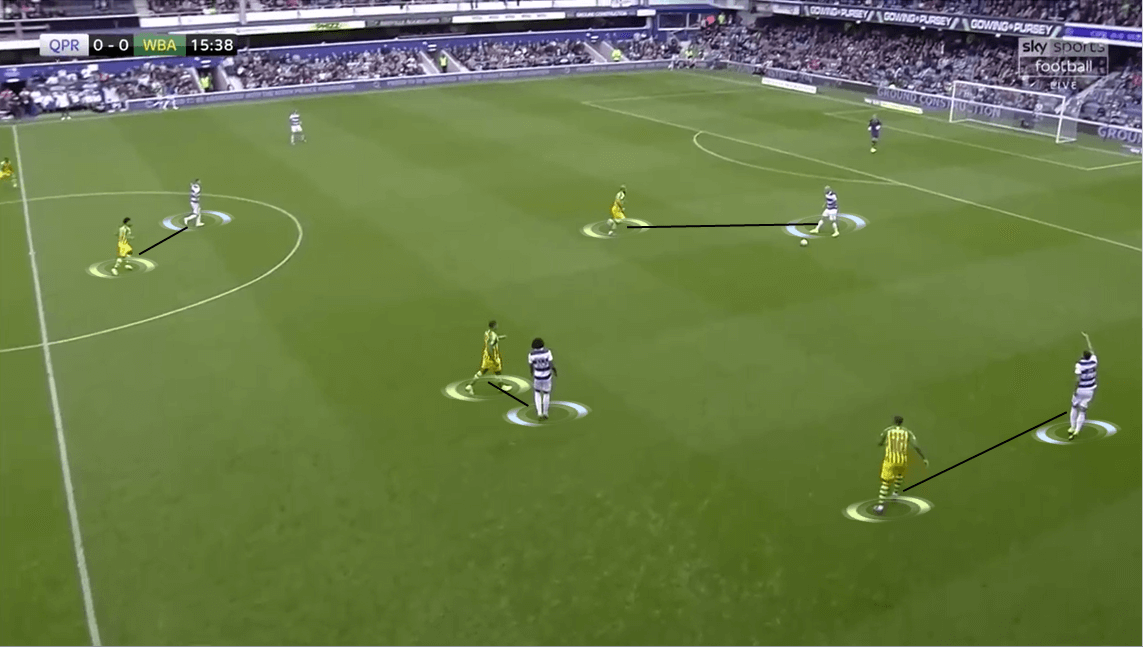
Deep inside their half, they created a clear 4-2-3-1 defensive shape that concentrated on defending the central area. Usually, Livermore and Sawyers would drop deep to create a shield in front of the defensive line and also took on the responsibility of intercepting passes and prevented long shots.
But, keeping things compact in front of the box didn’t benefit them on most occasions. While they were able to shift the shape laterally to create overloads on certain side of the pitch, there were times that they didn’t manage to do so. In the shot below, West Brom formed two defensive lines in front of the box with two centre-backs followed Hugill and Wells.
At the same time, Furlong was responsible for marking Chair and prevented the Moroccan midfielder from making passes. But when Manning attempted to make an overload into the left-hand side, the former QPR defender was confused as he would eventually create space for either of them moved in. This allowed Chair to find Manning just by a simple through ball and it resulted in a dangerous attack for the home side. Fortunately, Manning’s cross didn’t manage to find any of the strikers who positioned inside the box.
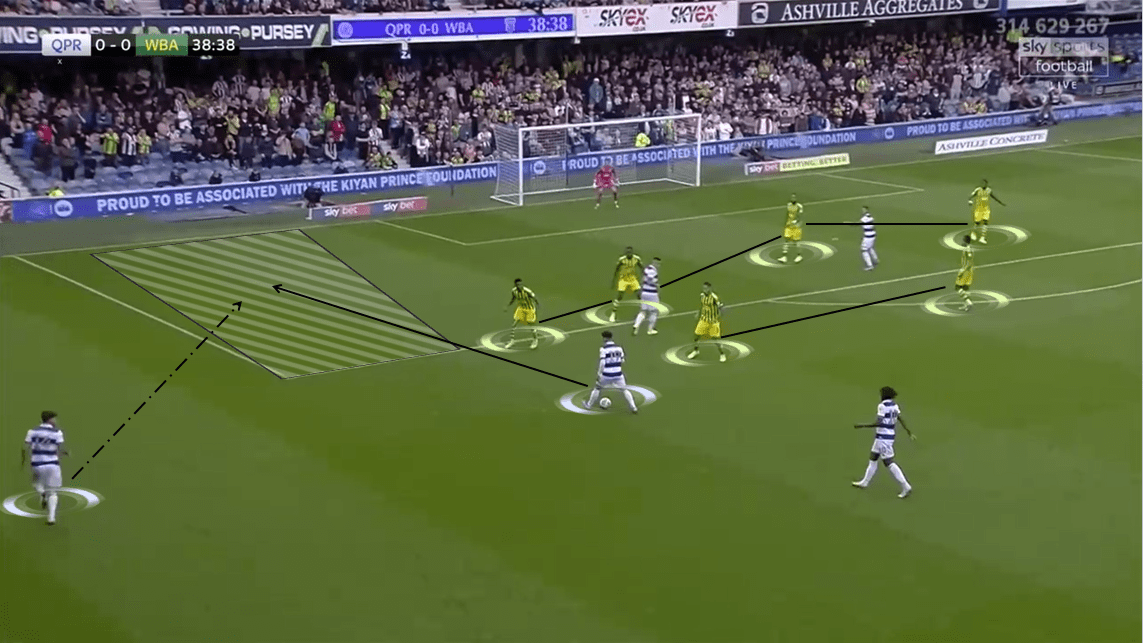
Conclusion
It’s fair to say that both Queens Park Rangers and West Bromwich Albion have brought us a very interesting matchup on the tactical perspective. They were two teams who placed close to each other on the league table and have a very eye-catching style of play. With that in mind, it’s no surprise that the fans were treated with a very thrilling match.
Although the first half didn’t show signs of positive as both teams struggled to find ways to approach each other’s goal, things have changed significantly in the latter period. West Brom side found it’s hard to progress the ball into the final third. In the end, the more superior team in West Brom deserved to get three points from this match while QPR should acknowledge the errors that they showed in this match.

If you love tactical analysis, then you’ll love the digital magazines from totalfootballanalysis.com – a guaranteed 100+ pages of pure tactical analysis covering topics from the Premier League, Serie A, La Liga, Bundesliga and many, many more. Buy your copy of the September issue for just ₤4.99 here





Comments